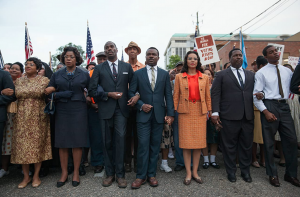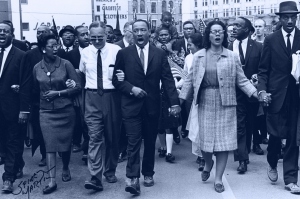70 Selma (2014)
Marching toward Justice in Selma
By Anonymous
Ava DuVernay’s Selma is a complex film mired in conflict and history. At its heart is the campaign to secure full voting rights for African Americans with the march from Selma to Montgomery serving as its nexus. I choose this film for its historical consistency and compelling performances. Selma is able to draw from history and show the internal conflict within the civil rights movement in 1964-1965. Martin Luther King (David Oyelowo) is the main protagonist though it also stresses the importance of the collective and highlights other important figures too.
The civil rights movement in America is long and amorphous; however, Selma‘s story starts at Dr. King’s Nobel prize ceremony for his work in civil rights. The film makes an earnest effort to humanize the legends of history surrounding the civil rights movement between 1964-65. Before Dr. King’s speech, he is distracted by his ascot, and during it, he is reminded of the past events that compel him. Selma immediately has us looking backward to help orient us in history, provide a sense of scope and give an idea of what motivates Martin Luther King. Dr. King begins his speech at the esteemed ceremony in well-lit room filled with dignitaries and elites.
“I accept this honor for our lost ones, whose deaths pave our path, and for the more than twenty million American Negroes” …the scene fades.
We flashback to a sunlit church in Birmingham Alabama. Four little girls chatter while walking down the church steps and past ornate stained glass on their way to service. As the frame focuses on one girl, mid-sentence an explosion interrupts her. The totality of the tragedy is revealed as the motionless children lay buried in rubble. A reminder of the radical discrimination that left no place safe for people of color. The Birmingham bombing took place the year prior, September 15, 1963 (Parrott-Sheffer, C., n.d.). King described it as “one of the most vicious and tragic crimes ever perpetrated against humanity.”
Title I of the 1964 Civil Rights Rct granted equal voting rights to people but had some critical flaws. In the courthouse in Selma, Alabama, where Annie Cooper (Oprah Winfrey) slowly and quietly fills out her voter registration in anticipation of exercising her newly given right. Downtrodden, she approaches the clerk’s booth. The close-up exchange of expressions conveys the causality and mutual understanding of the racism of the time. The everyday racism of the clerk alludes to the power dynamic, they both know Annie is eligible to register, but they also know she is powerless. Inevitably we arrive at a close-up of “DENIED” stamped across her registration as sad music shuffles Annie away, looking down at her feet, crushed. A straightforward example of the shortcomings of the civil rights act. It showcases the imbalance of power despite the law and contextualizes Cooper’s link to the struggle.
The Civil Rights Act is only six months old, and Martin Luther King has come to discuss voting rights again. They exchange pleasantries before sitting down to discuss matters of the nation, and the tone changes. The President asks, “How can help?” Dr. King asks for the fulfillment of voting rights for African Americans. President Johnson points out that African Americans had the right to vote through the 1964 civil rights act. King explains the flagrant denial of voting rights in the South. President Johnson tries to pivot priorities to the war on poverty as he towers over King and pats him on the back. King’s face scrunched with frustration but remains composed, explaining the gaps in enforcement in the South. He also points out that registering to vote is a prerequisite for serving on a jury, further contributing to inequalities in the system. King requests a federal law that guarantees the right to vote without restriction and robust enforcement of the law. President Johnson tries to postpone any further action for now.
This scene is crucial to the movie. The Birmingham bombers escaped conviction, likely due to a lack of enforcement and African American jurors. (Parrott-Sheffer, C., n.d.) The scene also incorporates Annie Cooper’s story into the movie by showing how easy it was to deny her vote and what little recourse she had to refute the decision. Additionally, it lays out the contrast between King and Johnson, who could not be more different in background and perception. This is also where things start to get tricky.


Martin Luther King is a legendary civil rights leader and humanitarian. He also had his issues; adultery among one. However, President Johnson has even more mixed and colorful history. He is on record, having used the n-word multiple times. As a senator, he opposed every civil rights measure, over 20 in total. President Johnson knew of the FBI’s wiretap on Martin Luther King and received regular updates (Conversation WH6707-01-12005, Presidential Recordings Digital Edition):
From December 1963 until his death in 1968, Martin Luther King, Jr. was the target of an intensive campaign by the Federal Bureau of Investigation to “neutralize” him as an effective civil rights leader. (Senate Select Committee to Study Governmental Operations with Respect to Intelligence Activities pg. 81)
The program was funded and continued for years on the assumption that Dr. King’s or his advisors were secret communists through the program never produced any evidence. The program continued years after his advisor quit and broke ties.
We have seen no evidence establishing that either of those Advisers attempted to exploit the civil rights movement to carry out the plans of the Communist Party. (Senate Select Committee to Study Governmental Operations with Respect to Intelligence Activities pg. 85)
President Johnson also passed the Civil Rights Act of 1964 and later the voting rights act of 1965. He waged war on poverty, reformed healthcare, and increased federal funding for education. DuVernay’s depiction of President Johnson was consistent with historical text. The director of the FBI was able to falsely convince him that there was a chance that Dr. King had secret communist ties. Martin Luther King was a keystone player in the civil rights movement. Without him there it was no unifying strategy or pressure to change. But President Johnson is the actual agent of change, and that is due to his position foremost, but ultimately his openness to being persuaded to do something he doesn’t initially understand or want to do. Johnson has a character arc that lands him in a good place, and it is hard not to see him as a flawed hero by the end of the film. A march on Selma wouldn’t make sense if Martin Luther King and President Johnson were on the same page at that time. Selma (2014) offers a reasonable and logical course between these events.
No one is spared in the telling of Selma. What I covered only accounts for the first ten minutes of this two-hour film, but those minutes are crucial. Selma shows the civil rights movement was not just a unifying of America, but a hard-fought battle among a fractured America for its future. Selma is not an easy movie to watch, but it does reward patience and understanding. It illustrates how easy it was to subvert the civil rights act of 1964 and how it served to placate white Americans. I appreciate how much care was put into explicitly speaking to the principle of the issues and showing real-world examples played out. It does a great job of outlining the strategies that overcame deep and powerful racism in America. Most of all, it makes a solid case on how the march on Selma was instrumental in the civil rights movement.
REFERENCES
“Is Selma Historically Accurate?” The Guardian, Guardian News and Media, 12 Feb. 2015, www.theguardian.com/film/2015/feb/12/reel-history-selma-film-historically-accurate-martin-luther-king-lyndon-johnson.
Lyndon B. Johnson Presidential Library. “Selma” movie. Accessed Wed. 25 Aug 2021. http://www.lbjlibrary.org/press/selma-movie.
“Lyndon B. Johnson and J. Edgar Hoover on 25 July 1967,” Conversation WH6707-01-12005, Presidential Recordings Digital Edition [Lyndon B. Johnson and Civil Rights, vol. 2, ed. Kent B. Germany] (Charlottesville: University of Virginia Press, 2014–). URL: http://prde.upress.virginia.edu/conversations/4005335
Martin Luther King Jr. – Acceptance Speech. NobelPrize.org. Nobel Prize Outreach AB 2021. Wed. 25 Aug 2021. https://www.nobelprize.org/prizes/peace/1964/king/acceptance-speech/
Parrott-Sheffer, C. (n.d.). 16Th Street Baptist Church bombing. Encyclopædia Britannica. https://www.britannica.com/event/16th-Street-Baptist-Church-bombing
Senate Select Committee to Study Governmental Operations with Respect to Intelligence Activities. Supplementary Detailed Staff Reports on Intelligence Activities and the Rights of Americas: Book III. Report No. 94-755. Washington, DC: U.S. Government Printing Office, 1976. (https://archive.org/details/finalreportofsel03unit)

